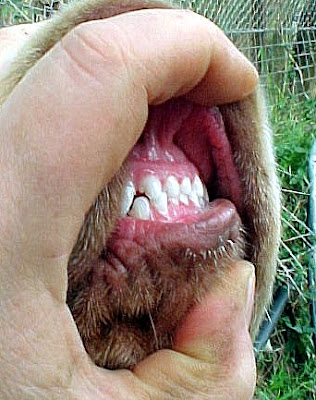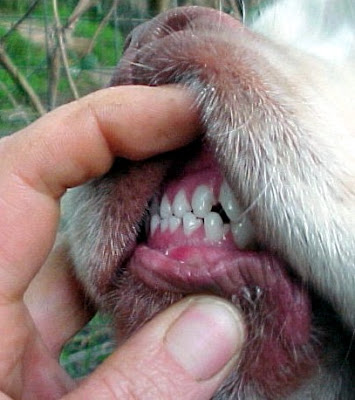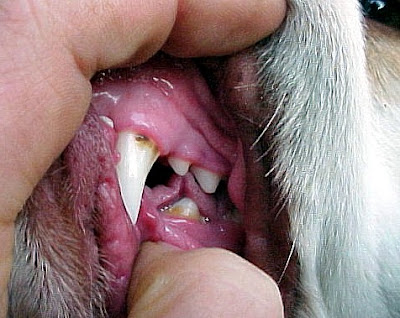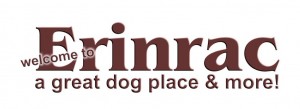This is a complicated issue, often ignored or misunderstood. This article is not complete, but gives some information which I will perhaps remember to add to later.

A sample of a correct/scissor bite in the breed, although in breeding I lean for a full depth scissor bite to avoid bite issues.

A level bite, fairly common in the breed, but still prone to unusual incisor wear due to the additional tooth to tooth contact on the cutting edges.

This photo shows the premolars correctly cut – the breed has a history of not cutting these (so allowing a good scissor bite) or of cutting them late which can lead to a good bite going bad or off at or after ten months of age as the eruption of the premolars (unless there is appropriate space) can push the lower incisors forward.
RESOURCES
see Leon Whitney
25-7-2010 very detailed & illustrated dental article http://www.dentalvet.com/patients/orthodontics/pet_orthodontics.htm
25-7-2010 technical but lovely pics http://www.dentalvets.co.uk/docs/Classification%20of%20Dental%20Occlusion%20in%20Dogs.pdf
see Living with Bad Bites
MALOCCLUSION CLASSIFICATION
One classification of malocclusion is based on the length of the maxilla in relation to the length of the mandible.
class I malocclusion is one in which one or more teeth are incorrectly aligned but the mandible-to-maxilla relationship is normal.
class II malocclusion—also termed an overbite, overshot, or, more accurately, overjet —occurs if the mandible is relatively shorter than the maxilla.
class III malocclusionalso termed an underbite, undershot, or, more accurately, underjet —occurs if the maxilla is shorter than the mandible.
from http://veterinarymedicine.dvm360.com/vetmed/Medicine/ArticleStandard/Article/detail/357732
(25 July 2010)
OTHER DEFINITIONS THAT MAY BE OF INTEREST
Overshot – top incisors protrude excessively in front of the lower ones (the upper or over jaw is ‘shot’/proud)
Overjet = overshot
Pig jaw = overshot
Bird faced = overshot (as typical of most bird beaks, the upper bill overlaps the lower bill)
Parrot mouth = overshot (upper is noticeably longer than the lower beak)
Brachygnathia = overshot
overbite = overshot
class II malocclusion = overshot
Undershot – lower jaw incisors sit forward of the upper ones (the lower or under jaw is ‘shot’/proud)
Underjet = undershot
Prognathism = undershot
Underbite = undershot
class III malocclusion = undershot
Habsburg jaw = undershot
Habsburg lip = undershot
Austrian Lip = undershot (these last three conditions are considered polygenic in humans – see Wikipedia)
Lantern jaw = undershot (often ‘thin’)
Sow-mouth = undershot (Sydney Univ)
Pig jaw = undershot (Sydney Univ)
Hogmouth = undershot (Sydney Univ)
OTHER INFORMATION THAT MAY BE OF INTEREST
A genetic study of class III malocclusion
Stephen F. Litton D.D.S., Leonard V. Ackermann D.D.S., M.S.D., Robert J. Isaacson D.D.S., Ph.D. and Burton L. Shapiro D.D.S., Ph.D.
From the Division of Orthodontics, University of Minnesota School of Dentistry, Minneapolis, Minn., USA
Abstract
The families of fifty-one probands demonstrating Angle Class III malocclusion were examined. Approximately 13 per cent of the siblings of the probands exhibited the trait, suggesting a strong genetic influence in the transmission of Class III malocclusion.
No evidence was found to suggest that the trait is sex linked. The results did not support a simple autosomal dominant mode of transmission. The results also did not support a simple autosomal recessive transmission. The explanation most compatible with the results seems to be a polygenic method of transmission depending on a threshold beyond which persons are at risk. The possibility that different methods of transmission exist in different families or different populations has not been ruled out.
Major gene and multifactorial inheritance of mandibular prognathism†
1. Ricardo Machado Cruz1,*,
2. Henrique Krieger2,
3. Ricardo Ferreira2,
4. James Mah3,
5. James Hartsfield Jr4,
6. Silviene Oliveira1
Article first published online: 11 DEC 2007
Copyright © 2007 Wiley-Liss, Inc.
Issue
American Journal of Medical Genetics Part A
Volume 146A, Issue 1, pages 71–77, 1 January 2008
Abstract
Mandibular prognathism typically shows familial aggregation. Various genetic models have been described and it is assumed to be a multifactorial and polygenic trait, with a threshold for expression. Our goal was to examine specific genetic models of the familial transmission of this trait. The study sample comprised of 2,562 individuals from 55 families. Complete family histories for each proband were ascertained and the affection status of relatives were confirmed by lateral cephalograms, photographs, and dental models. Pedigrees were drawn using PELICAN and complex segregation analysis was performed using POINTER. Parts of some pedigrees were excluded to create one founder pedigrees, so the total N was 2,050. Analysis showed more affected females than males (P = 0.030). The majority of the pedigrees suggest autosomal dominant inheritance. Incomplete penetrance was demonstrated by the ratio of affected/unaffected parents and siblings. The heritability of mandibular prognathism was estimated to be 0.316. We conclude that there is a major gene that influences the expression of mandibular prognathism with clear signs of Mendelian inheritance and a multifactorial component. © 2007 Wiley-Liss, Inc.
see http://onlinelibrary.wiley.com/doi/10.1002/ajmg.a.32062/abstract
Sheep: http://onlinelibrary.wiley.com/doi/10.1002/ar.1090920305/abstract
The Veterinary Record, Vol 130, Issue 17, 375-376
Copyright © 1992 by British Veterinary Association
Inheritance of ‘overshot’ malocclusion in German shorthaired pointers
MJ Byrne and GM Byrne
An abnormality of jaw development in the German shorthaired pointer which results in severe overshot is described. Its frequency of occurrence in a kennel where only phenotypically normal breeding stock were used was six/100 pups alive at three weeks. The abnormality was inherited in a manner consistent with the influence of a single autosomal recessive gene. The penetrance of the gene could possibly be masked in populations in which undershot jaw occurs.
see http://veterinaryrecord.bmj.com/content/130/17/375.abstract
Stoddart
see http://jhered.oxfordjournals.org/cgi/pdf_extract/38/4/117
[hr]
My all time favourite reference so far
Pavlica, Erjavec, and Petelin’s Teeth Abnormalities in the Dog Acta Vet Brno 2001 70: 65-72
